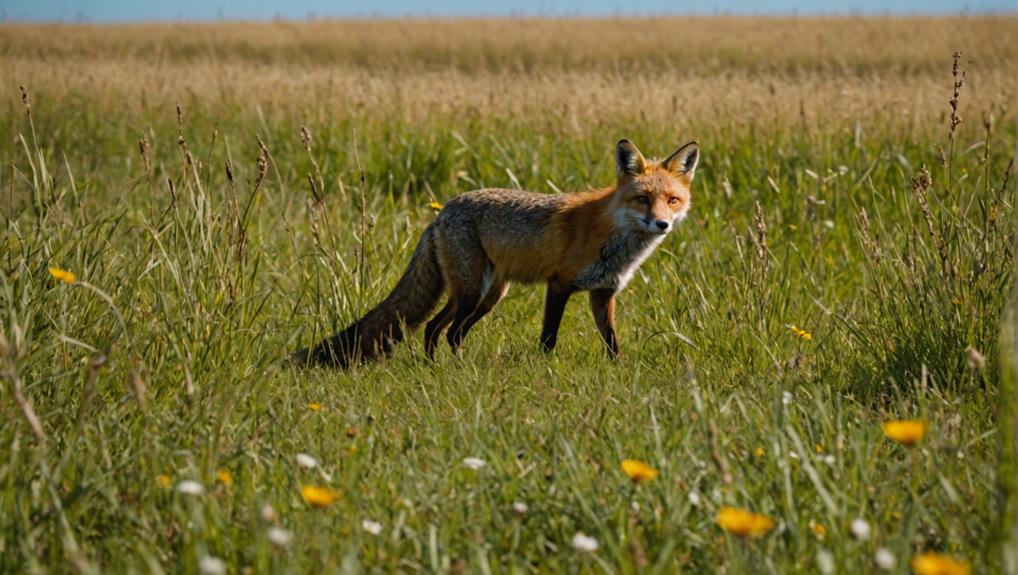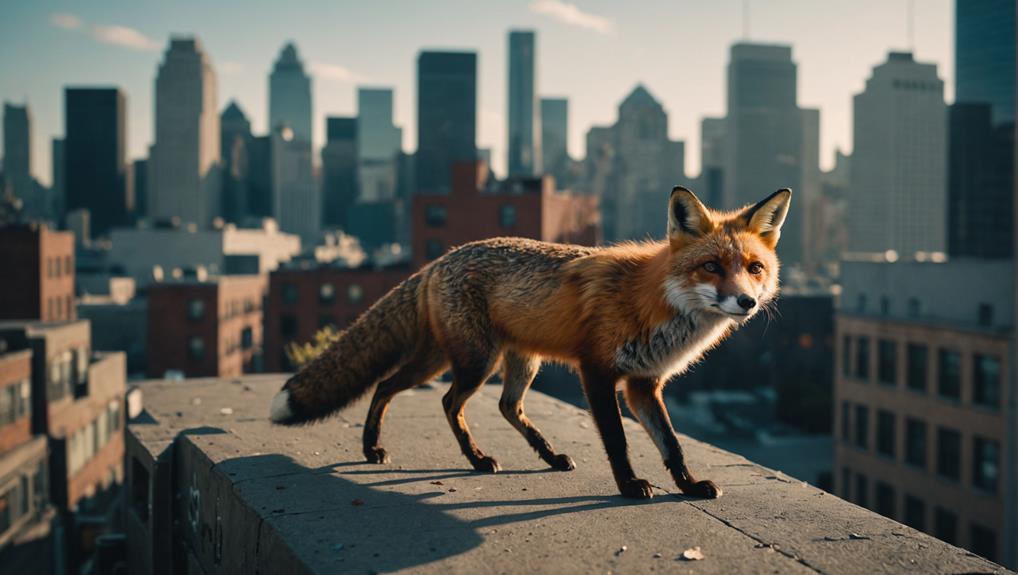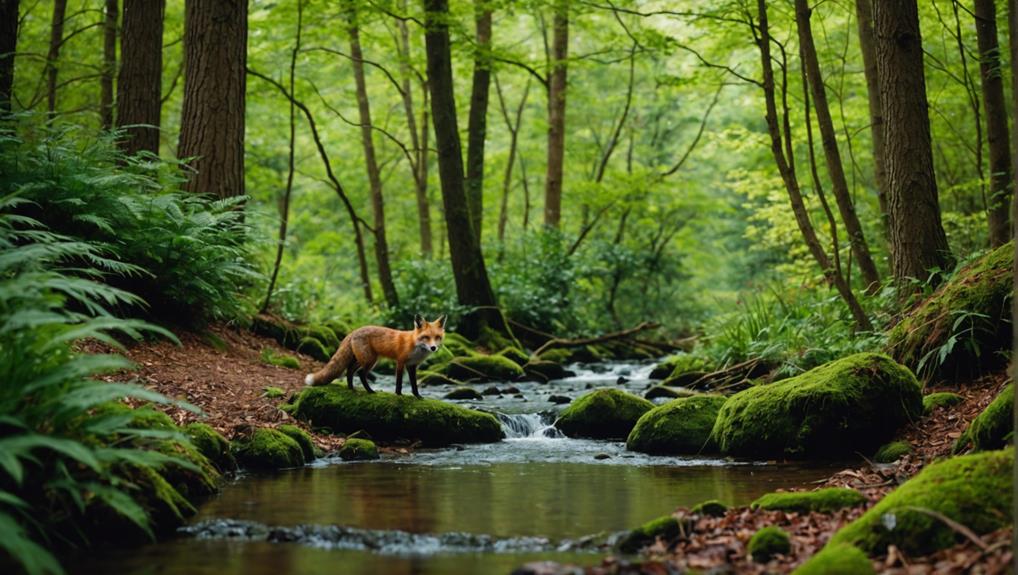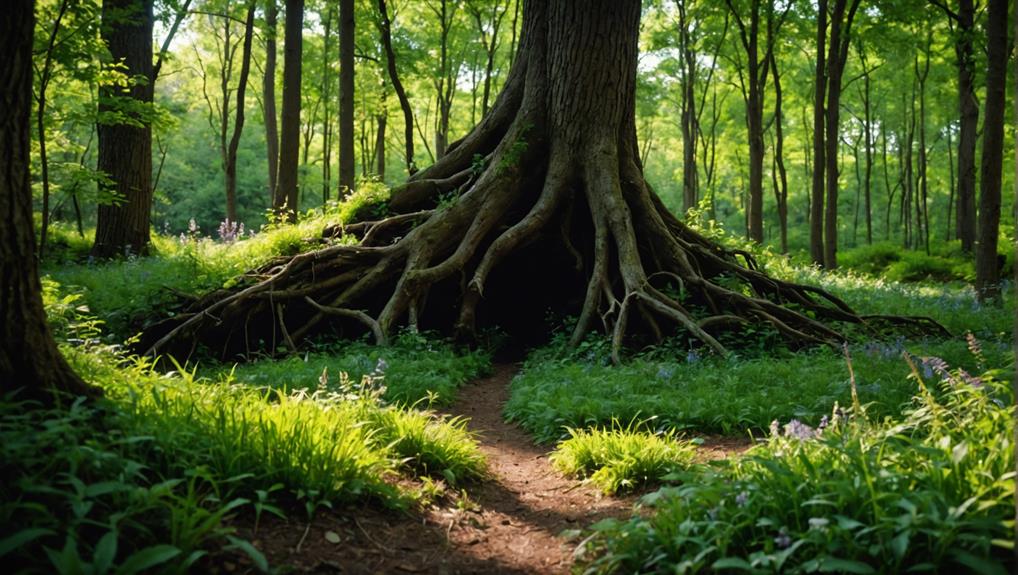Red foxes are pretty adaptable critters, making themselves at home in a range of habitats. They love mosaic forests and young conifer plantations, where they find food and shelter. You can also spot them in grasslands, hunting for small mammals or lurking in arctic tundra, staying warm even in freezing temps. Urban areas are a surprising favorite, too, as they scavenge around gardens and parks. Lastly, conservation areas offer safe spots to thrive. They really know how to pick their places, don't they? Keep an eye out, and you might learn about some unique habitats these foxes enjoy!
Contents
Overview of Red Fox Habitats
When you think of red fox habitats, picture a diverse landscape where these clever animals can thrive. Red foxes aren't picky eaters or residents; they adapt beautifully to various environments. Their preferred habitats often include mosaic forests, especially young conifer plantations, where food availability and shelter come together like a perfect dinner party.
You might be surprised to learn that urban areas have become a popular spot for red foxes, too! They've figured out how to navigate gardens, parks, and even streets, all while scavenging for tasty treats. Imagine spotting one in your neighborhood, confidently strutting past your trash cans.
Seasonal changes also play a role in where red foxes hang out. They'll move around based on breeding seasons and food availability, making them quite the resourceful creatures.
However, they tend to steer clear of flat open country, sparse woodlands, and arable fields since these spots don't offer the food and shelter they need.
Forests: A Preferred Territory
Forests are essential territories for red foxes, providing the perfect blend of food and shelter. These clever critters thrive in diverse forested environments, especially in mosaic forests. You'll find that young conifer plantations are particularly important. They offer essential cover and a variety of food sources, which helps keep the foxes well-fed and safe from danger.
During breeding seasons, red foxes often switch up their habitats, moving to different forest areas based on where their prey is most plentiful. It's like nature's way of saying, "Adapt or starve!"
In mature forests, these furry friends find rest sites where they can retreat and stay hidden from potential threats. It's not just about food; it's also about safety!
Dense woodlands provide the best conditions for fox hunting, but keep in mind that competition can be tough. Tawny owls, for example, can impact fox abundance and prey density in larger woodlands.
Grasslands: The Hunting Grounds

Red foxes thrive in diverse environments, and grasslands serve as prime hunting grounds. These open spaces are like a buffet for them, full of small mammals, birds, and insects. Thanks to the sparse vegetation, foxes can spot their dinner from afar.
With their sharp hearing, they can even hear a tiny rodent burrowing underground—talk about having a sixth sense!
The patchy grasslands also offer cover, which helps foxes sneak up on their prey. Picture a little furry ninja, stalking its target quietly!
As the seasons change, so does the availability of food. Foxes cleverly adapt their hunting strategies and diets, making sure they're never left hungry.
Plus, grasslands often sit next to other ecosystems, like forests and wetlands. This proximity increases habitat diversity, allowing foxes to explore and gather resources from their neighbors.
It's like living in a neighborhood where everyone shares snacks!
Arctic Tundra: Survival in the Cold
The Arctic tundra presents a unique challenge for foxes, but these clever canines have mastered the art of survival in this frigid landscape. With temperatures often plunging below -30°C (-22°F), red foxes rely on their thick fur and layers of fat to stay warm. You might think it's tough to find food in such a barren place, but red foxes have a smart strategy. They primarily feast on small mammals like lemmings and voles, especially during the brief summer months when the ground thaws.
Here's a quick look at how red foxes thrive in this chilly habitat:
| Adaptation | Description |
|---|---|
| Insulation | Thick fur and fat layers keep them warm. |
| Hunting skills | Acute hearing helps locate prey under the snow. |
| Denning sites | Use underground burrows or dig their own dens. |
| Population stability | Their adaptability ensures stable populations. |
Despite the harsh conditions, red foxes showcase remarkable resilience. So next time you think of the Arctic tundra, remember these furry survivors and their incredible journey of survival in the cold!
Urban Environments: Adapting to Humans

While red foxes have adapted to survive in extreme environments like the Arctic tundra, they've also found a way to thrive in urban settings. These clever creatures are recognized as the most urbanized canids, often boasting higher population sizes in cities than in rural areas. Isn't that impressive?
They adapt quickly to their surroundings, taking advantage of gardens, parks, and streets for hunting and scavenging. You might even spot them rummaging through trash bins, showing just how resourceful they are!
Urban foxes can raise their cubs in these bustling environments. In fact, some families have been spotted denning in unexpected places, like Yankee Stadium! It's a bit funny to think of foxes making a home amidst all that human activity, isn't it?
As they colonize suburban areas, they prefer middle-class neighborhoods with private gardens, which offer cozy nesting spots and fewer disturbances.
With significant populations popping up in major cities worldwide, red foxes are proving they can coexist with us. So, the next time you see one, remember they're not just surviving—they're thriving right alongside us, adapting to life in urban environments!
Conservation Areas: Safe Havens
Conservation areas are like cozy homes for red foxes, giving them the chance to roam free without the hustle and bustle of city life.
These safe havens boast a mix of woodlands, fields, and even urban green spaces, making it easier for foxes to hunt and raise their young.
Protected Wildlife Reserves
Many people may not realize how crucial protected wildlife reserves are for red foxes. These safe havens offer essential habitats where red foxes can thrive, away from the hustle and bustle of human activity. In these reserves, red foxes find diverse ecosystems that support their hunting, denning, and raising young.
| Benefits of Protected Reserves | Impact on Red Foxes |
|---|---|
| Rich in diverse ecosystems | Provides essential habitats |
| Higher prey densities | Supports hunting success |
| Shelter from human disturbances | Aids in raising young |
| Mitigates habitat loss | Ensures stable populations |
Urban Green Spaces
Protected wildlife reserves aren't the only places where red foxes can thrive; urban green spaces also play a significant role in their survival. You might be surprised to learn that these parks and conservation areas can be vital habitats for our furry friends.
Here's how urban green spaces help red foxes:
- Diverse Habitats: The mix of scrub, woodlands, and open meadows provides the perfect setting for red foxes to find shelter and raise their young, away from disturbances.
- Food Sources: Gardens and well-kept landscapes boost the availability of prey, like small mammals and birds, ensuring foxes can fill their bellies without venturing too far.
- Adaptation and Movement: Red foxes have shown they can adapt to urban life, with higher populations found in city areas compared to rural ones. These green spaces allow them to move easily between urban and rural settings, keeping their options open for mating and foraging.
Isn't it heartwarming to think that by nurturing these urban green spaces, we're not just beautifying our neighborhoods but also helping red foxes thrive?
It's a win-win for everyone involved!
Sustainable Agricultural Lands
Sustainable agricultural lands serve as vital safe havens for red foxes, offering a rich tapestry of habitats that include scrub, woodlands, and farmland. These areas create a perfect blend of environments where red foxes can hunt, den, and thrive. You might be surprised to learn how these lands promote habitat diversity, which is essential for maintaining healthy fox populations.
| Habitat Type | Benefits for Red Foxes | Example Species |
|---|---|---|
| Scrub | Great for hiding and hunting | Small mammals |
| Woodlands | Offers shelter and safety | Birds and rodents |
| Farmland | Abundant food sources | Insects and crops |
Impact of Biodiversity on Habitats

Have you ever thought about how the variety of life around us shapes the habitats where red foxes live?
When ecosystems are rich and diverse, it means more tasty snacks for these clever critters and cozy spots to hide.
Plus, a balanced environment helps keep competition low, so our furry friends can flourish without worrying too much about resource shortages.
Habitat Variety Importance
Understanding the importance of habitat variety is crucial for supporting red fox populations. When you think about it, a diverse habitat truly enhances the chances of survival for these clever creatures.
Here are three reasons why habitat variety matters:
- Biodiversity boosts food availability: With a mix of woodlands, farmlands, and scrub areas, red foxes can find small mammals, birds, and even insects. This variety keeps their dinner plate full and varied.
- Ecosystem resilience: A rich ecosystem can bounce back from challenges like habitat loss and climate change. This resilience is vital for red foxes, as they need a stable environment to thrive.
- Improved shelter options: Different habitats offer multiple denning sites and safe spots. Red foxes need these safe havens to raise their young and escape predators.
Species Interdependence Dynamics
Recognizing the intricate web of species interdependence is vital when considering the impact of biodiversity on habitats, especially for red foxes. These clever creatures not only hunt but also play a significant role in controlling rodent populations. By keeping these small mammals in check, red foxes help maintain healthy vegetation and overall ecosystem balance. Isn't nature amazing?
Here's a quick look at how red foxes interact with their environment:
| Species Interaction | Impact on Ecosystem |
|---|---|
| Red foxes and rodents | Help control rodent populations |
| Red foxes and game species | Increase food sources for foxes |
| Seasonal changes and foraging | Showcase adaptability of red foxes |
| Urban foxes and native species | Shift dynamics in altered environments |
These interactions illustrate the delicate balance of nature. When red foxes thrive, they positively influence their surroundings. You can see how their adaptability allows them to coexist with various species, even in urban settings. By understanding these relationships, we can appreciate the importance of preserving habitats for red foxes and the diverse wildlife with whom they share their homes.
Ecosystem Balance Maintenance
While red foxes may seem like just another component of the ecosystem, they play a pivotal role in maintaining balance within their habitats. You might be surprised to learn how essential these clever creatures are, especially when it comes to controlling populations of small mammals, like rodents.
Here's how they contribute to ecosystem balance:
- Regulating Rodent Populations: By preying on rodents, red foxes help keep their numbers in check, preventing overgrazing that can harm plant life.
- Promoting Biodiversity: Their hunting habits ensure no single species dominates, which supports a rich variety of plants and animals.
- Adapting to Urban and Rural Settings: Red foxes thrive in both areas, sharing genetic material and enhancing resilience across different ecosystems.
These little predators don't just keep the food web spinning; they're like nature's balancing act.
Final Thoughts
In summary, red foxes thrive in a variety of habitats, from lush forests to bustling cities. They've got a knack for adapting, which is pretty impressive! Whether they're hunting in grasslands or cozying up in urban areas, these clever creatures remind us of nature's resilience. Protecting their habitats is crucial for their survival and our ecosystem's health. So, let's celebrate these charming foxes and do our part to ensure they have safe spaces to call home!














